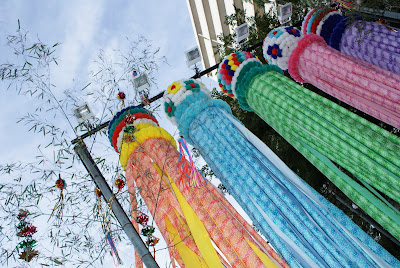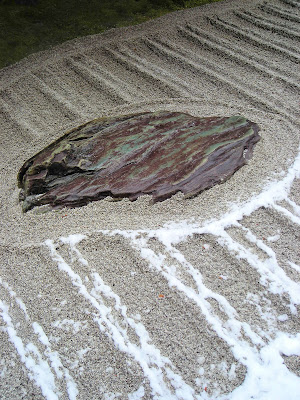16th August 2011
Kyoto city's celebrations for the star festival of Tanabata ended yesterday with the close of Kyo no Tanabata, a 10-day event staged at different spots.
I spent a few sweaty hours at the site beside Horikawa, a river in the west of the city. This is what it looked like before the crowds arrived.

Bamboo art installation. Those probably aren't mosquito nets though they would have been entirely appropriate given the number of times I was bitten.

Decorations made famous by the celebrations in Sendai, which holds one of the largest Tanabata festivals in Japan. Those decorations are huge - as if they'd been made by a race of giants keen on handicrafts and jellyfish.

In its non-festival hours, the Horikawa site is a park for residents.

Fire-fighting in Kyoto begins with a red bucket. The bucket is always filled - fire seems to be a bigger worry than mosquito-breeding.

Everything looked different once night fell and the spotlights came on in the bamboo grove. Strips of paper with wishes on them had been hung up among the leaves as well as decorations like this one.

The highlight of the celebrations at the Horikawa site: a tunnel evoking the Milky Way, which separates Orihime the weaver and Hikoboshi the cowherd for 364 days a year. The Sky Emperor allows them to meet on the seventh day of the seventh month but if the weather's bad, they won't.
In all the shots I took of the tunnel, this was the only one where the light at the end formed a perfect heart.
So maybe things worked out for Orihime and Hikoboshi this year.

In the river, fabric from one of the city's dyers was displayed: a nod to the past practice of washing excess dye out of kimono material in the river.



The changing lights constantly remade the same stretch of cloth.


A cry went up among the crowd when these blue LED balls came bobbing down the river.

Releasing the balls into the river. He had a walkie-talkie - wrapped in plastic - to communicate with those downstream and a stopwatch hanging from his neck. He would check it before dropping the balls into the water; he was probably on a schedule.

The first electric tram in Japan apparently crossed a bridge over the Horikawa. The tram is long gone but this remains.

The Sendai decorations at night.

Water wheels were set up near the streamers with messages to the March disaster victims fixed to the blades. This wheel said, "You're not alone".

No comments:
Post a Comment